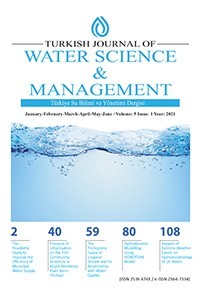Yeraltı Suyunun Kalite ve Miktar Bakımından Yönetimi: Gediz Nehir Havzası Örnek Çalışması
yeraltı suyu yönetimi, miktar ve kimyasal durum değerlendirmesi, tedbirler programı, Gediz Nehir Havzası
Management of Groundwater Quality and Quantity: Gediz River Basin Pilot Study
groundwater management, quantitative and chemical status assessment, programme of measures, Gediz River Basin,
___
- EEA (European Environment Agency). (2012). Corine Land Cover (Coordination of Information on the Environment Land Cover, CLC)
- European Commission. (2000). Water Framework Directive (WFD) Directive 2000/60/EC of the European Parliament and of the Council of 23 October 2000 establishing a framework for Community action in the field of water policy, Official Journal of the European Parliament, L327, 22.12.2000.
- European Commission. (2006). Groundwater Directive (GWD) Directive 2006/118/EC of the European parliament and of the council on the protection of groundwater against pollution and deterioration, Official Journal of the European Union, L372, 27.12.2006.
- European Commission. (2014). Groundwater Directive (GWD) Commission Directive 2014/80/EU 20 June 2014 amending Annex II to Directive 2006/118/EC of the European Parliament and of the Council on the protection of groundwater against pollution and deterioration, Official Journal of the European Union, L182, 21.06.2014.
- EU FP6 (The Sixth Framework Programme, European Union). (2006). BRIDGE (Background cRiteria for the IDentification of Groundwater thrEsholds) Project. Project ID: 6538.
- MoFWA (Ministry of Forestry and Water Affairs of Turkey). (2013). BPAP (Basin Protection Action Plan) for Gediz Basin. TÜBİTAK Marmara Research Center, Kocaeli, Turkey.
- MoFWA (Ministry of Forestry and Water Affairs of Turkey). (2013). Action Plan on Groundwater Management 2013 – 2024, Ankara, Turkey.
- MoFWA (Ministry of Forestry and Water Affairs of Turkey). (2015). Hydrogeological Investigation Report for Gediz Basin. Eser Project and Engineering, İzmir, Turkey.
- MoFWA (Ministry of Forestry and Water Affairs of Turkey). (2015). DPPSG (Determination of the Pollutants having Potential to Seep into Groundwater). ENCON Environmental Consultancy Co., Ankara, Turkey.
- MoFWA (Ministry of Forestry and Water Affairs of Turkey). (2017). Total Maximum Daily Load (TMDL) Approach Implementation in Gediz River Basin. TÜBİTAK Marmara Research Center, Kocaeli, Turkey.
- MoFWA (Ministry of Forestry and Water Affairs of Turkey). (2017). Implementations for Determination and Assessment of Groundwater Quantity And Quality: Gediz Basin Pilot Study Project. Fugro Sial Geosciences Consulting and Engineering Ltd. Co., Ankara, Turkey.
- Turkish Republic Official Gazette. (2012). Bylaw on “Protection of Groundwater against Pollution and Deterioration”, 282457, 07.04.2012.
- Turkish Republic Official Gazette. (2015). Revision of the Bylaw on “Protection of Groundwater against Pollution and Deterioration”, 29363; 22.05.2015.
- ISSN: 2536-474X
- Başlangıç: 2017
- Yayıncı: Tarım ve Orman Bakanlığı Su Yönetimi Genel Müdürlüğü
Invasive Macroinvertebrate Species Monitored in the Turkish Coast between 2014 and 2015
Yeraltı Suyunun Kalite ve Miktar Bakımından Yönetimi: Gediz Nehir Havzası Örnek Çalışması
Özgür ÇAKMAK, Burcu DURU, Ahmet Fuat YARGICI, Osman Şerif GÜLTEKİN, Caner TOPÇU, Ülkü YETİŞ, Onur Fatih BULUT, Filiz B. DİLEK
Determination of the Most Suitable Assessment Methods of River Hydromorphology for Turkey
Identifying Surface Runoff Distribution and Amount in Stream Basins: Ergene River Basin
